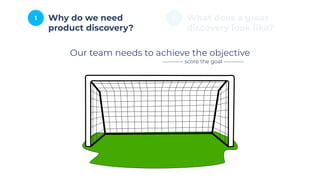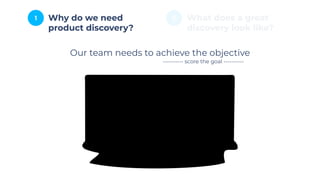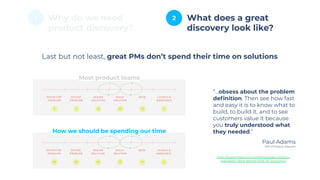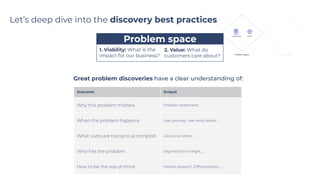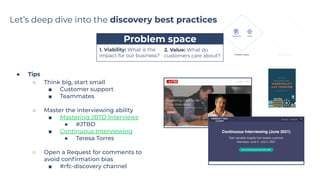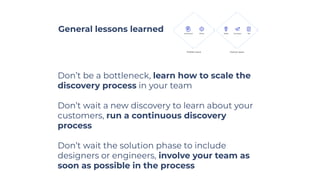Product Discovery @ Nubank
- 1. Discovery @ Nubank Regional PMs Lunch
- 2. Hi, I’m Gus co-founder @ Nutricart nutritional products marketplace / we don’t sell products, we help people achieve their life goals - responsible for product and also a mobile/front-end developer // failed miserably 😂 product manager @ RD Station crm & digital marketing software / biggest SaaS B2B in LatAm - responsible for adoption, how to make customers achieve mid-term success and habit formation // achieved negative churn product manager @ Nubank digital bank / biggest digital bank (35M customers) and third most valuable fintech in the world ($25 bi) - responsible for: - chargeback, scale the largest cs team // first 100% self-service experience - customer experience (aka customer support), sustainably grow the business by 3x // 70% of tickets successfully solved by serf-service experience (smart FAQ and chatbot) - international expansion, build a global business // launch the product in MX and COL & one of the largest credit card issues in less than a year in MX 2019- 2021 2017- 2019 2013- 2015 A product lover passionate about design, numbers and experimentation. In my free time, you will find me playing FPS games or practicing sports (judo, biking or running). When covid goes away, I will continue my journey of getting to know different cultures (did a backpack in LATAM). Professional life
- 3. Discovery @ Nubank ● In 2020, we hired more than 50 PMs. ● How are we going to maintain a high quality product?
- 4. Discovery @ Nubank ● In 2020, we hired more than 50 PMs. ● How are we going to maintain a high quality product? How can we make sure that we’re choosing the right problems to solve? chapter priorities Let’s define our product discovery process!
- 5. NO AGREEMENT
- 6. ● Products in different stages NO AGREEMENT ● Different types of product management https://www.reforge.com/blog/product-work-beyond-product-market-fit
- 7. Lessons Learned ● One size does not fit all ● But, we need to create a guide to scale with quality and have a similar language to be able to help each other
- 8. Lessons Learned ● One size does not fit all ● But, we need to create a guide to scale with quality and have a similar language to be able to help each other 1 2 Why do we need product discovery? What does a great discovery look like?
- 9. 1 2 Why do we need product discovery? What does a great discovery look like? Our team needs to achieve the objective
- 10. 1 2 Why do we need product discovery? What does a great discovery look like? Our team needs to achieve the objective ---------- score the goal ----------
- 11. 1 2 Why do we need product discovery? What does a great discovery look like? Our team needs to achieve the objective ---------- score the goal ----------
- 12. 1 2 Why do we need product discovery? What does a great discovery look like? Our team needs to achieve the objective ---------- score the goal ---------- complexity competitors timing
- 13. 1 2 Why do we need product discovery? What does a great discovery look like? Our team needs to achieve the objective ---------- score the goal ----------
- 14. 1 2 Why do we need product discovery? What does a great discovery look like? talked with customers Our team needs to achieve the objective ---------- score the goal ----------
- 15. 1 2 Why do we need product discovery? What does a great discovery look like? Our team needs to achieve the objective ---------- score the goal ---------- talked with customers analyzed data ran an experiment
- 16. 1 2 Why do we need product discovery? What does a great discovery look like? Our team needs to achieve the objective ---------- score the goal ---------- Product discovery aims to increase the odds of scoring the goal asap by reducing the uncertainties
- 17. 1 2 Why do we need product discovery? What does a great discovery look like?
- 18. 1 2 Why do we need product discovery? What does a great discovery look like? A clear understanding of the following risks: 1. Viability: What is the impact in our business? 2. Value: What do customers care about? 3. Usability: Will customers understand how to use it? 4. Feasibility: Will we have capacity to build it?
- 19. 1 2 Why do we need product discovery? What does a great discovery look like? But, before getting into the questions, it’s important to have a clear North Star - What is the expected outcome? Worse than not scoring the goal is scoring the wrong goal, it will generate a product debt that making it harder to use and working on the product. - What is the expected impact? The size of goal should reflect on how much time you will invest in the product discovery process or
- 20. 1 2 Why do we need product discovery? What does a great discovery look like? Last but not least, great PMs don’t spend their time on solutions Most product teams How we should be spending our time “...obsess about the problem definition. Then see how fast and easy it is to know what to build, to build it, and to see customers value it because you truly understood what they needed.” Paul Adams SVP of Product, Intercom https://www.intercom.com/blog/great-product- managers-dont-spend-time-on-solutions/
- 21. Let’s deep dive into the discovery best practices …...…..Problem space…..…... 1. Viability: What is the impact for our business? 2. Value: What do customers care about?
- 22. Let’s deep dive into the discovery best practices …...…..Problem space…..…... Start with a reflection: ● What I know that I know ○ List the assumptions ● What I know that I don’t know ○ Investigate the areas ● What I don’t know that I don’t know ○ Run exploratory research 1. Viability: What is the impact for our business? 2. Value: What do customers care about? https://www.nngroup.com/articles/ which-ux-research-methods/
- 23. Let’s deep dive into the discovery best practices …...…..Problem space…..…... 1. Viability: What is the impact for our business? 2. Value: What do customers care about? Great problem discoveries have a clear understanding of: Outcome Output Why this problem matters Problem statement, ... When the problem happens User journey, User story board, ... What users are trying to accomplish Jobs to be done, ... Who has the problem Segmentation target, ... How to be the top of mind Market research, Differentiators, ...
- 24. Let’s deep dive into the discovery best practices …...…..Problem space…..…... ● Tips ○ Think big, start small ■ Customer support ■ Teammates ○ Master the interviewing ability ■ Mastering JBTD Interviews ● #JTBD ■ Continuous Interviewing ● Teresa Torres ○ Open a Request for comments to avoid confirmation bias ■ #rfc-discovery channel 1. Viability: What is the impact for our business? 2. Value: What do customers care about?
- 25. …....…....Solution space…....…... 3. Usability: Will customers understand how to use it? 4. Feasibility: Will we have capacity to build it? Let’s deep dive into the discovery best practices
- 26. …....…....Solution space…....…... 3. Usability: Will customers understand how to use it? 4. Feasibility: Will we have capacity to build it? Let’s deep dive into the discovery best practices Great solution discoveries have: Outcome Output Clear success criteria KPIs tree, input and output metrics, counter metrics, ... Large volume of options Opportunity tree, ... Risk mitigator process Minimum Lovable Product Usability Test, Paper Prototype, Participatory Design, ... Process to acquire valuable knowledge Experimentation, Post-launch research, ...
- 27. ● Tips ○ Diverse group and collaborative to think about possible solutions ■ Piggyback ideas ■ Share all the information you have ○ Process just finishes when you solve the problem with a reasonable quality level (build for the long-term) ■ Watch out for product and UX debts ■ Analyze the data and talk with customers ○ Engineers should be close since the beginning of the design process to guide the designers to the most feasible path ■ If the designer invest too much time on the solution, they might get too emotional attached to the solution …....…....Solution space…....…... 4. Feasibility: Will we have capacity to build it? Let’s deep dive into the discovery best practices 3. Usability: Will customers understand how to use it?
- 29. General lessons learned Don’t be a bottleneck, learn how to scale the discovery process in your team https://uxdesign.cc/how-to-solve-problems-6bf14222e424
- 30. General lessons learned Don’t be a bottleneck, learn how to scale the discovery process in your team Don’t wait a new discovery to learn about your customers, run a continuous discovery process
- 31. General lessons learned Don’t be a bottleneck, learn how to scale the discovery process in your team Don’t wait a new discovery to learn about your customers, run a continuous discovery process Don’t wait the solution phase to include designers or engineers, involve your team as soon as possible in the process PM Designer Engineer PMM 5 15 5 5 5 10
- 32. General lessons learned Don’t be a bottleneck, learn how to scale the discovery process in your team Don’t wait a new discovery to learn about your customers, run a continuous discovery process Don’t wait the solution phase to include designers or engineers, involve your team as soon as possible in the process









